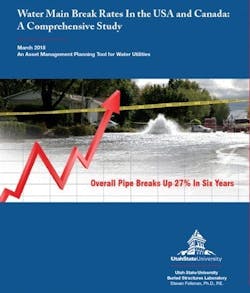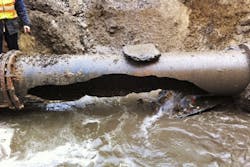About the author:
An environmental engineer, Hatler is chief revenue officer at Fracta Inc.
This article originally appeared in Technology Today, a supplement to Roads & Bridges. You can access the original version of this story on the Roads & Bridges here.
Water-quality issues are on the rise and water customer satisfaction is down as utilities admit that preventive pipe repair and replacement planning is more complicated.
Water utilities are finding that water main pipes are not failing in sequential order based on age. Newer water mains are failing and, in many cases, failing at higher rates than old pipe.
Pipe material condition and performance are key cost drivers to both the O&M and capital budgets, and water main breaks reflect the physical condition of a distribution system’s health. The U.S. Conference of Mayors reported that 86.2% of cities use the number of water main breaks per unit length to evaluate drinking water pipe performance. The Water Research Foundation (WRF) has supported that 75% of water utilities cited pipe breaks as a key criterion in pipe replacement decisions.
As a whole, the U.S. water industry has accepted that between 250,000 and 300,000 breaks occur every year, which corresponds to a rate of 25 to 30 breaks per 100 miles annually with the average pipe break rate (regardless of cause) for water utilities between 21 to 27 breaks per 100 miles of pipeline per year. Also, it has been suggested that when construction, third-party damage and maintenance errors are eliminated, the number of water main breaks based on pipe material drops below 15 breaks per 100 miles.
The 2018 report Practical Condition Assessment and Failure Probability Analysis of Small Diameter Ductile Iron Pipe from the WRF based on research by Purdue University and Louisiana Tech focused on the break rates of ductile iron (DI) pipe less than 12 in. in diameter. The findings take into consideration that many newer pipes with thinner walls may be failing at a higher rate than older pipes or larger-diameter DI pipes.
Small-diameter DI main break rate findings indicate the average total number of failures per year per 100 miles of small diameter DIP was 15.1 failures/year/100 miles.
Utah State University’s (USU) Buried Structures Laboratory released a new 2018 study on water main breaks in the U.S. and Canada. The USU study focused on water main breaks based on the pipe material and separated main breaks from third-party and maintenance damage and found that, nationally, all pipe materials are at 14 breaks per 100 miles of pipe per year, with over 300 utilities surveyed. Further research concluded that:
- Over 16% of installed water mains are beyond their useful life and do not have funding;
- The national rate of pipe replacement is 125 years;
- Overall water main pipe break rates have increased 27% in the past six years;
- Cast Iron (CI) main breaks have increased by 46% in six years; 82% of CI pipes are over 50 years old;
- Asbestos cement (AC) main breaks have increased by 43% in six years; 27% of AC pipe also is over 50 years in age;
- Most utilities have a moderate to high soil corrosion risk;
- CI pipe has 20 times more breaks in highly corrosive soils than in low corrosive soils;
- DI pipe has 10 times more breaks in highly corrosive soils than in low corrosive soils;
- 45% of utilities conduct condition assessment (CA) of water mains; and
- Smaller utilities have two times more main breaks than large utilities.
Overall, these key water industry findings tell a story that age and failure history by itself may not be reliable factors of determining the likelihood of failure (LoF) of pipes.
While condition assessment is at the core of asset management, enabling a utility to move from reactive to preventive asset maintenance and management strategies, accurate predictive analysis requires an enhanced digital analysis approach called Machine Learning (ML) which is a subset of Artificial Intelligence (AI).
Machine Learning Applied to Water Pipe Infrastructure
Asset management practices combined with ML for water mains provides a new solution of aligning maintenance, repair and replacement strategies to better allocate limited resources. Machine learning provides another asset management tool to help address the water industry’s most pressing concerns of producing an accurate prediction of water main LoF. Fracta, a technology company based in Redwood City, Calif., produces an accurate five-year model using ML to direct leak detection efforts, focus preventive maintenance crews, validate capital plans and align master planning efforts.
Machine learning algorithms need a large amount of historical and geospatial data. Water main condition assessment data contains all the necessary components for ML in water utilities with years of historical data. Analyzing this data consistently can uncover trends, gain insight on pipeline health and offer data-driven assessments. The more data the better, as the amount of data strengthens the predictive power of an ML algorithm.
Data acquisition, assessment and cleaning for any ML process is roughly 60-80% of the work, also known as pre-processing or data wrangling, with the remaining percentage being the ML itself. Once the data is assessed, cleaned and imputed where needed, it is ready to be fed into an algorithm where it is subsequently “trained” to learn the patterns that predict breakage events.
The more data a model contains, the more robust the model. As utilities are over time constantly collecting data such as new breaks and installed pipes, that data can continually be fed into an ML model.
New pipe data strengthens the predictive power of an ML algorithm. Machine learning also can benefit utilities with limited asset or breakage data by “filling in the gaps.” Machine learning can utilize many streams of data in order to perform certain predictions and begins to learn patterns that can inform situations where many of the usual data points may not be available, creating a new digital revolution in advanced asset management practices.
Desktop or computational approaches are by far the most cost-effective and least invasive, but many of these methods are based on arbitrary assumptions and weights, i.e., older pipes are more in need of replacement than newer pipes.
Analyzing this data consistently can uncover trends, gain insight on pipeline health and offer data-driven assessments. Pipe data and the surrounding environmental data covering installation year, pipe material, break history, pressure class, geographical location, elevation, pipe diameter, proximity to other infrastructure systems, and soil composition can all be taken into consideration while also assessing hundreds of other variables unique to a specific utility and pipe location.
Conclusion
As an ever-increasing amount of data strengthens the predictive power of an ML algorithm benefiting utilities with large amounts of historical breakage and asset information, ML also can benefit utilities with limited asset or breakage data as data can “fill in the gaps.” If a utility has little breakage data, future breaks can be informed by patterns found for other similar materials, install years, soil compositions, etc. If a utility has little asset data, a similar process can be applied by simply looking at ancillary geospatial data to impute the probability of pipe breakage events. Thus, because ML utilizes many streams of data in order to perform certain predictions, it begins to learn patterns that can inform situations where many of the usual data points may not be available.
Incorporating an AI-ML condition assessment tool into a proper infrastructure and asset management program will contribute to the reduction of the economic impacts incurred from water main breaks, and more efficient allocation of capital by water utilities. Use of best practices and a more accurate, objective tool will align maintenance and capital repair and replacement strategies to more efficiently leverage scarce financial and human resources. They also inject financial integrity to the planning process and refine the investment strategy so a utility will be in a better position to defend planning efforts and fund needed capital pipe replacement projects.



